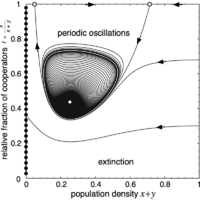Evolutionary Games and Population Dynamics
The emergence and abundance of cooperation in nature poses a tenacious and challenging puzzle to evolutionary biology. Cooperative behavior seems to contradict Darwinian evolution because altruistic individuals increase the fitness of other members of the population at a cost to themselves. Thus, in the absence of supporting mechanisms, cooperation should decrease and vanish, as predicted by classical models for cooperation in evolutionary game theory, such as the prisoner's dilemma and public goods games.
Traditional approaches to the problem of cooperation based on the replicator dynamics assume constant (infinite) population sizes and thus neglect the ecology of the interacting individuals. Here we incorporate ecological dynamics into evolutionary games and reveal a new mechanism for maintaining cooperation whenever the population density depends on the average population payoff. Defection decreases the population density, due to small payoffs, resulting in smaller interaction group sizes in which cooperation may be favoured. This feedback between ecological dynamics and game dynamics generates fascinating and rich dynamical behavior. Such Ecological Public Goods Games represent natural extension of replicator dynamics to populations of varying densities.
Ecological Public Goods
Bifurcations in well-mixed populations

In infinite populations where individuals randomly interact in public goods games, cooperators are doomed and readily disappear. In contrast, varying population densities can lead to stable coexistence of cooperators and defectors in public goods games. When increasing the efficiency of the public good the system undergoes a series of bifurcations and the dynamics ranges from extinction, to periodic oscillations and finally stable co-existence.
Pattern formation in spatial populations

Spatial 'reaction-diffusion' dynamics promotes cooperation based on different types of pattern formation processes. Individuals can migrate (diffuse) in order to populate new territories. Slow diffusion of cooperators fosters aggregation in highly productive patches (activation), whereas fast diffusion enables defectors to readily locate and exploit these patches (inhibition). These antagonistic forces promote co-existence of cooperators and defectors in static or dynamic patterns, including spatial chaos of ever changing configurations.
References
- Wakano, J. Y., Martin A. Nowak & Hauert, Ch. (2009) Spatial Dynamics of Ecological Public Goods, Proc. Natl. Acad. Sci. USA X, X.
- Hauert, Ch., Wakano, J. Y. & Doebeli, M. (2008) Ecological Public Goods Games: cooperation and bifurcation, Theor. Pop. Biol. 73, 257-263.
- Hauert, Ch., Holmes, M. & Doebeli, M. (2006) Evolutionary games and population dynamics: maintenance of cooperation in public goods games, Proc. R. Soc. Lond B 273, 2565-2570. Corrigendum: Proc. R. Soc. Lond B 273, 3131-3132.